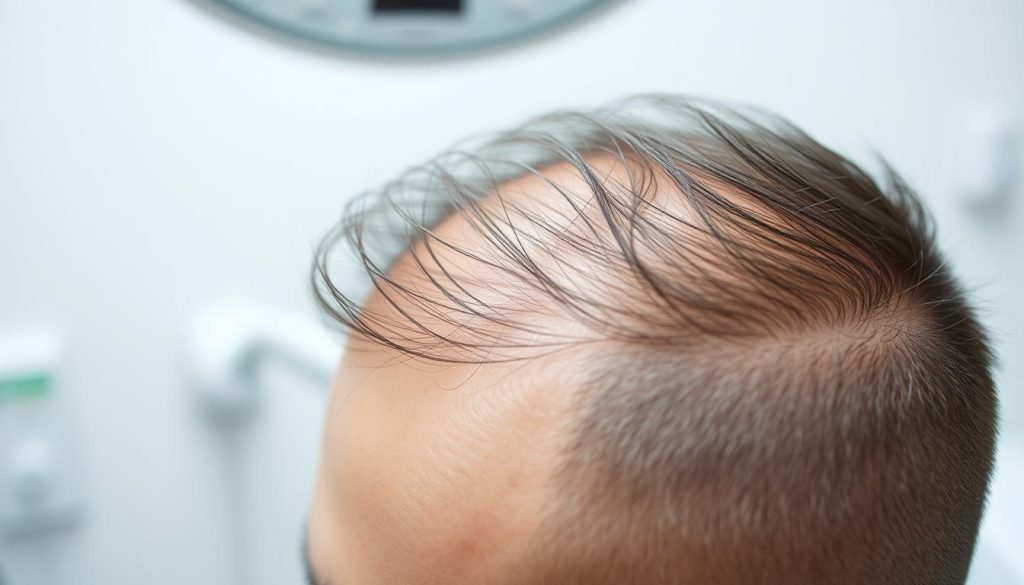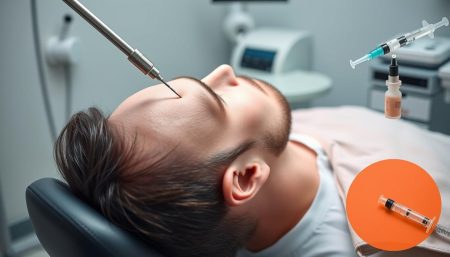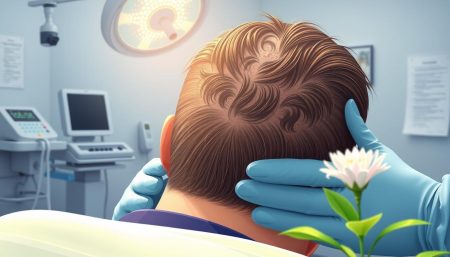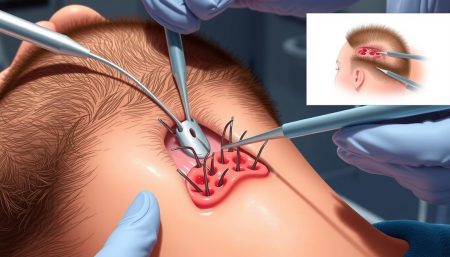Starting your journey to get fuller, natural hair can be scary and confusing. This FUT hair transplant guide is here to help you understand hair restoration. It breaks down each step and considers every detail to help you on your way.
Learning about the FUT hair transplant is a big step towards looking the way you want. It’s important to find a guide that is both caring and knowledgeable. This guide aims to educate you while also understanding the emotional side of hair loss.
In this guide, you’ll learn the best ways to restore your hair. You’ll get personal insights and see how natural hair growth is possible. Start this journey with confidence, knowing this guide is here to support you.
Understanding FUT Hair Transplant Technology
Exploring FUT hair restoration shows the tech behind it. It’s important to know the difference between FUT vs. FUE and the power of hair transplant technology. This section dives deep into why Follicular Unit Transplantation (FUT) is a top choice for those fighting hair loss.
How FUT Differs from Other Hair Restoration Methods
FUT takes a strip of tissue from the back of the head. It’s then cut into individual follicular units with great care. This is different from Follicular Unit Extraction (FUE), where hair follicles are taken directly from the scalp without a strip.
FUT has less scarring and can give more hair in one go. This is a big plus for those with a lot of balding, making it better than FUE for some.
The Science Behind Follicular Unit Transplantation
FUT works because of donor dominance. The transplanted hair grows as it did before, making results last. This science makes the hair look natural after the transplant.
FUT is a mix of art and science. It needs a deep understanding of hair angles and scalp health for natural results. New tech in hair transplant technology has made FUT better, with less recovery time and more reliable results.
| Attribute | FUT | FUE |
|---|---|---|
| Technique | Strip harvesting | Individual follicle extraction |
| Scarring | Linear scar at donor site | Multiple small scars |
| Number of Grafts | Higher in a single session | Lower due to meticulous extraction |
| Best Uses | Extensive balding | Smaller areas, detail work |
| Recovery Time | Longer due to surgical nature | Quicker, less invasive |
Who is the Ideal Candidate for a FUT Hair Transplant?
Finding the ideal FUT hair transplant candidate is key for success. This section helps you figure out if you’re a good fit. It’s all about getting the best results from this advanced hair restoration method.

Follicular Unit Transplantation (FUT) is for those with a lot of hair loss but enough hair on the back of their head. People who are good candidates share certain traits. These traits help make the transplant work better.
- Age and Hair Loss Stability: The best candidates are over 25. At this age, hair loss is more steady. This makes it easier for surgeons to plan the transplant.
- Healthy Donor Area: The back of your head needs dense, healthy hair. This hair will be moved to thinning spots.
- Elasticity of the Scalp: A flexible scalp makes it easier to take out the strip. It also lowers the chance of problems after surgery.
- Realistic Expectations: Knowing what the procedure and recovery are like is important. It’s true for any cosmetic surgery, including hair transplants.
A skilled surgeon will check if you’re a good candidate. They look at your hair density, how thick and colored your hair is, and your overall health.
| Candidate Quality | Details |
|---|---|
| Hair Density at Donor Site | High hair density required for effective transplantation |
| Scalp Elasticity | Scalp flexibility needed for strip extraction |
| Age Factor | Ages 25 or older preferred, where hair loss is more defined and pattern stability assessed |
| Health Status | Good overall health supports better post-surgery healing and integration |
This guide talks about important factors for being the ideal FUT hair transplant candidate. It’s smart to talk to a hair transplant surgeon. They can give you a personal check-up. They’ll tell you if FUT is right for you.
Preparations for a FUT Hair Transplant Procedure
Starting a FUT hair transplant journey can be both exciting and nerve-wracking. Getting ready for your FUT hair transplant can make a big difference. This includes scheduling your consultation and learning about what to do before the surgery.
Initial Consultation with a FUT Hair Transplant Surgeon
Your journey starts with a FUT transplant consultation. The surgeon will look at your hair loss, talk about what you can expect, and explain the surgery. This is your chance to share your hopes and worries and get a plan that fits you.
What to Do Before Your FUT Hair Transplant
- Avoiding certain medications: Some medicines can affect bleeding and healing, so it’s important to review your medications with your surgeon.
- Smoking and alcohol: For optimal healing, quitting smoking and avoiding alcohol a few weeks before and after the procedure is recommended.
- Arranging transportation: As you will receive anesthesia, ensure you have someone to drive you home post-procedure.
Getting ready for a FUT hair transplant is more than just physical prep. It’s also about being ready mentally for the changes ahead. By following these tips, you can make your surgery and recovery smoother.
The Step-by-Step FUT Hair Transplant Process
Learning about the FUT hair transplant process is key for those thinking about it. Knowing the steps can ease worries, set clear expectations, and help patients make better choices. Here, we outline the main steps in the FUT method.
FUT hair transplant process has several important phases. Each phase is vital for the success of the procedure. Below, we explain each step:
- Consultation and Planning: First, the patient talks with the surgeon. They discuss goals, check scalp health, and plan the procedure. They decide how many and where the grafts will go.
- Donor Hair Removal: Next, a strip of scalp from the back of the head is removed. This area is chosen because the hair follicles there are less likely to fall out.
- Follicular Unit Preparation: The removed strip is then carefully dissected under a microscope. This is done to isolate individual follicular units.
- Recipient Site Preparation: The surgeon then prepares the bald or thinning areas. They make tiny incisions at specific angles and depths to match natural hair growth.
- Transplantation: The prepared follicular units are then implanted into the incisions. This is done to ensure the hair looks natural.
- Post-operative Care: After the procedure, detailed instructions for home care are given. These instructions help with healing and hair growth.
The table below shows the average time for each stage of the FUT hair transplant process:
| Stage | Duration | Description |
|---|---|---|
| Consultation and Planning | 1-2 hours | Discussion of hair restoration goals and strategy |
| Donor Hair Removal | 1 hour | Strip extraction from donor site |
| Follicular Unit Preparation | 2-3 hours | Dissection of donor strip into individual grafts |
| Recipient Site Preparation | 30-60 minutes | Creation of recipient incisions |
| Transplantation | 2-4 hours | Placement of grafts into recipient site |
| Post-operative Care | Varies | Home care instructions and follow-up visits |
Understanding the FUT hair transplant process and its steps helps patients feel more confident and clear about their journey.
Choosing the Best FUT Hair Transplant Clinic
Starting your journey to a fuller head of hair with Follicular Unit Transplantation (FUT) means picking the right clinic is key. It’s important to check the qualifications of hair transplant surgeons and look at clinic success rates. This guide will help you choose the best place for your FUT hair transplant.
Evaluating Surgeon Credentials and Experience
Looking into a surgeon’s qualifications, years of experience, and FUT technique expertise is essential. A skilled surgeon can greatly impact your procedure’s success. Make sure to check their medical education, board certification, and involvement in hair restoration societies.
- Confirm board certification in dermatology or surgery
- Check for membership in recognized medical societies such as the ISHRS
- Review before and after photos of previous FUT patients
- Seek testimonials and direct feedback from former patients
Understanding Clinic Success Rates and Reviews
When picking a FUT hair transplant clinic, look at their success history. Success rates can be seen in verified patient reviews and ratings. It’s not just about the number of successes, but also the quality of those results.
- Read online reviews from reputable health care rating platforms
- Analyze success rates published on the clinic’s official site
- Assess the transparency and detail in presenting case studies
- Explore external forums for unbiased opinions
Choosing the right clinic is about finding a balance between professional skill and patient success. By doing your research and evaluating surgeons and clinics, you can make a confident choice. This ensures a successful procedure and a great experience.
FUT Hair Transplant
Looking into the differences between Follicular Unit Transplantation (FUT) and Follicular Unit Extraction (FUE) helps patients understand their options. It also shows what makes FUT hair transplants effective. Knowing these details is key for those thinking about this life-changing procedure.
Comparing FUT with FUE – Pros and Cons
FUT and FUE are both top-notch hair restoration methods, but they work in different ways. FUT vs FUE is a debate many patients and doctors have. FUT takes a strip of scalp to get follicular units, while FUE picks them out one by one from the scalp.
- Scarring: FUT leaves a straight scar, while FUE might have small dot scars.
- Recovery Time: FUT takes longer to heal because it’s a more invasive method.
- Cost: FUE is often pricier because it needs more precision and time.
- Efficiency: FUT can transplant more grafts in one go.
Each method has its own benefits. It’s important for patients to talk to skilled surgeons to find the best choice for them.
Key Factors That Influence FUT Hair Transplant Success
Several important factors affect the success of a FUT hair transplant. These factors help ensure the results are better than expected.
| Success Factor | Description |
|---|---|
| Patient Health | The health and quality of the donor area greatly impact success. |
| Surgeon’s Skill | The surgeon’s skill and precision are key to a good outcome. |
| Post-Procedure Care | Good care after surgery is essential for graft success. |
By using FUT wisely and following up well, the chances of a successful transplant are much higher.
Post-Procedure Care for Optimal FUT Hair Transplant Results
Getting the best results from a Follicular Unit Transplantation (FUT) depends on good care after the procedure. This care is key for healing and success of the transplant.
- Keep the surgery area clean to avoid infections.
- Stay out of direct sunlight and cover your scalp from UV rays for a few weeks.
- Use the treatments or take the medicines your surgeon tells you to for better healing.
- Avoid heavy activities and exercises that can stress the scalp or cause sweating.
- Sleep with your head raised to reduce swelling and avoid rubbing the transplanted area.
Regular visits to the clinic are vital for post-procedure care. They let the doctor check on your healing and make sure the hair follicles are doing well. These visits are key to getting the best results, as they help catch any problems early.
It’s very important for those getting a FUT hair transplant to follow these care steps closely. Learning about post-procedure FUT care helps with healing and keeps the transplant results lasting longer and better.
Managing Expectations: What to Expect After a FUT Hair Transplant
Knowing the FUT hair growth timeline and what to expect after a transplant is key. This guide will help you understand the recovery phase and when to get medical advice.
Timeline of Hair Growth After FUT
Hair growth after a FUT transplant varies but follows a common pattern. Here’s what usually happens:
- Initial Shedding: The transplanted hair will shed in the first few weeks. This means the new growth cycle is starting.
- Noticeable Growth: By 3-4 months, you’ll see hair growth. This is when you’ll notice an improvement in density and coverage.
- Mature Hair Growth: Around 8-12 months after, the hair will mature and thicken. This gives you the final look you want.
The FUT hair growth timeline can last up to a year. During this time, you’ll see different stages of growth, leading to the full result.
When to Seek Help for Post-Transplant Complications
FUT transplants are usually safe, but knowing about possible complications is important. Here are signs you should talk to your surgeon:
- Persistent Redness or Swelling: Some swelling is normal, but if it lasts more than a few days or redness doesn’t go away, get advice.
- Signs of Infection: Excessive pain, pus, or severe itching could mean an infection. You need to see a doctor right away.
- Unusual Hair Loss: If hair loss keeps happening or shows up in patches, it might be a sign of something else.
By knowing the FUT hair growth timeline and when to get help, you can manage your recovery better. This makes your post-transplant journey smoother.
Real Patient FUT Hair Transplant Results Showcases
Looking at patient hair restoration showcases gives us a clear view of FUT’s success. Below are real stories of FUT transplant results from around the world:
Each story is a unique journey to hair recovery. It makes complex medical talk real. We make it easy to see how FUT hair transplant works and how long it takes.
| Age | Gender | Time Post-Procedure | Visual Change | Patient Satisfaction Level |
|---|---|---|---|---|
| 34 | Male | 12 Months | Fuller Frontal Hairline | Highly Satisfied |
| 29 | Female | 8 Months | Significant Density in Crown Area | Satisfied |
| 45 | Male | 10 Months | Enhanced Hair Texture and Coverage | Very Satisfied |
| 50 | Female | 14 Months | Complete Bald Spot Coverage | Highly Satisfied |
The table shows a range of FUT transplant results. It varies by age, gender, and healing time. It shows how FUT improves looks and boosts confidence. These real stories prove FUT is a reliable choice for hair restoration.
In conclusion, these patient hair restoration showcases show more than just looks. They show the life-changing impact of FUT. They offer hope and proof for those thinking about it.
Average FUT Hair Transplant Cost and Financing Options
Understanding the FUT hair transplant cost and hair transplant financing options can help ease the financial stress. It’s key to look at both direct and indirect costs.
Analyzing the Components of Total FUT Transplant Cost
The cost of a FUT hair transplant varies based on several factors. These include the procedure’s complexity, the surgeon’s experience, and the clinic’s location. Prices can differ a lot, so it’s vital to know what you’re paying for. Learn more about the factors that affect the cost.
The main cost factor is the number of grafts needed, priced per graft. Other expenses include the surgical facility, anesthesia, and postoperative care supplies.
Insurance and Financing for Your Hair Restoration
Most insurance doesn’t cover hair transplant procedures because they’re seen as cosmetic. But, there are many hair transplant financing options. Clinics often offer payment plans or work with financial institutions for structured financing.
It’s wise to talk to different clinics to compare FUT hair transplant cost and financing plans. This helps find the best price and service.

Making an informed decision on hair transplant financing is critical. It can mean getting top-quality treatment or settling for less. Planning well is essential, and using available resources can help plan finances for this life-changing procedure.
Minimizing Scarring and Maximizing Growth with FUT Transplants
Getting a Follicular Unit Transplantation (FUT) can change your life if you’re losing hair. But, it’s key to minimize FUT scarring and maximize hair transplant growth for a natural look. This part will show you how to keep your transplant looking good and growing strong.
Keeping your scalp clean and healthy before and after surgery is very important. It helps your new hair grow well. For more tips on keeping your results lasting, check out hair transplant durability.
- Post-Operative Care: Follow your surgeon’s advice closely to avoid harming your scalp or slowing healing.
- Gentle Washing: Only wash your hair when your doctor says it’s okay, using soft, non-irritating products.
- Medicated Shampoos: Use shampoos that help scars heal and are made for after-transplant care to help your hair grow.
- Nutrition: Eat foods full of vitamins and minerals to make your hair and scalp strong.
To lessen FUT scarring, use treatments and steps your surgeon suggests:
- Use silicone gel sheets or scar creams that doctors approve for healing after surgery.
- Stay out of direct sunlight on your scalp to prevent scars from getting darker and to heal faster.
- Once healed, gently massage the area to improve blood flow and reduce scar tissue.
| Technique | Benefit | Application Time Frame |
|---|---|---|
| Gentle Scalp Cleaning | Prevents infection and supports natural healing | Immediately post-op and onwards |
| Hydration and Nutrition | Supports follicle health and scar minimization | Pre-op and ongoing after surgery |
| UV Protection | Prevents scar darkening and promotes even healing | Post-operative, specially in sunny places |
Also, keep up with reliable info and talk often with your doctor. This helps a lot in minimizing FUT scarring and maximizing hair transplant growth. Remember, the success of a hair transplant is not just in the surgery, but in the care after.
Risks and Complications Associated with FUT Hair Transplants
Choosing a Follicular Unit Transplantation (FUT) can change your life. But, it’s key to know the risks and complications. Knowing these helps you prepare and have a smooth recovery.
How to Minimize Potencial Side Effects
FUT is a common hair restoration method. But, like any surgery, it comes with risks. To lower these risks, pick a skilled surgeon and follow their advice carefully. Here are some tips:
- Choose a certified surgeon with a lot of FUT experience.
- Tell your surgeon about any health issues or medicines you take.
- Follow the pre-surgery rules, like avoiding certain drugs.
- Keep your scalp clean after surgery and follow all care tips to avoid infections.
- Go to all your follow-up appointments to check on your healing.
By following these steps, you can lessen the common side effects of FUT.
Understanding Long-Term Risks of FUT Method
FUT hair transplants can have long-term risks. These include scarring and uneven hair growth. These can affect how you look and might need more treatment. Also, think about how you’ll feel about the changes in your appearance.
- Scarring: The scar from the donor site might show if you wear your hair very short.
- Uneven Growth: Transplanted hair might grow differently, needing more treatment or correction.
- Psychological Impact: Changing how you look can be tough for some people.
Knowing these complications helps you make better choices and have realistic hopes for your FUT journey.
Choosing the Right FUT Hair Transplant Surgeon
Finding the right FUT surgeon is key to a successful hair transplant. It’s not just about the results but also feeling comfortable and trusting the process. Understanding your hair loss and the surgery options is where the surgeon’s expertise matters most.
Questions to Ask FUT Specialists
- What is your experience with FUT hair transplant surgeries?
- Can you share patient testimonials and outcomes specific to FUT procedures?
- How do you customize treatment plans based on different hair loss patterns?
- What are the post-operative support and follow-up guidelines you offer?
Assessing Surgeon’s Gallery of Before and After Photos
Looking at a surgeon’s before and after photos is very telling. These pictures show their skill and how well they meet individual beauty needs.
Make sure the photos show a range of cases. This shows the surgeon can work with various hair types and loss patterns. Seeing diverse results can help you decide.
Choosing a FUT specialist is a big step in your hair restoration journey. Trust, proven results, and clear communication are essential in making your choice.
Advancements in FUT Hair Transplant Techniques
In the world of hair restoration, FUT technique advancements have brought new hope. These changes have made hair transplantation more effective. Now, hair loss treatments are better than before, thanks to these improvements.
The use of NeoGraft in 2009 has been a big step forward. It makes the hair transplant process easier and less invasive. Patients now get results that look natural and heal without visible scars.
The future of FUT hair transplants looks bright. Scientists are working hard to make these procedures even better. They aim to make hair transplants not just effective but also comfortable and life-changing. Medical experts are dedicated to improving hair restoration technology, promising even better results in the future.
FAQ
Q: What makes the FUT hair transplant technique different from other hair restoration methods?
A: Follicular Unit Transplantation (FUT) is unique because it removes a strip of scalp tissue. Then, it extracts individual follicular units from this strip. These units are then implanted into balding areas. This method is favored for its efficiency and ability to increase hair density.
Q: Who qualifies as an ideal candidate for a FUT hair transplant?
A: The best candidates have enough donor hair, stable hair loss, and realistic hopes. Those with large balding areas might prefer FUT for its ability to harvest many grafts at once. Good health is also key for healing and growth.
Q: What preparations need to be made before undergoing a FUT hair transplant procedure?
A: Before the procedure, avoid blood-thinning meds and supplements. Don’t smoke or drink alcohol. Get a good night’s sleep. A consultation with a surgeon will outline specific pre-op steps.
Q: What can be expected during the FUT hair transplant process?
A: The process starts with local anesthesia. Then, a scalp strip is removed and sutured. The strip is dissected into follicular units, which are then implanted. The whole process can take several hours, depending on graft numbers.
Q: How do you choose the best FUT hair transplant clinic and surgeon?
A: Look for board-certified surgeons with FUT experience. Read patient reviews and check before-and-after photos. Also, evaluate clinic success rates and reviews.
Q: What factors play a critical role in ensuring a successful FUT hair transplant?
A: Success depends on the surgeon’s skill, patient health, and post-op care. Following up with the surgeon is also vital. These factors help achieve the best transplant results.
Q: What post-procedure care is essential for optimal FUT hair transplant results?
A: Follow the surgeon’s wound care instructions and avoid strenuous activities. Don’t wash your hair for a few days. Take prescribed meds to prevent infection. Proper care ensures healing and hair growth.
Q: What should patients expect after a FUT hair transplant, in terms of recovery and hair growth?
A: Expect a healing period where the scalp recovers and new hair grows. Some hair may fall out initially. But, new hair should be visible in three to four months, with full results in six to twelve months.
Q: What is the average cost of a FUT hair transplant, and what are the financing options?
A: Costs vary based on graft numbers, surgeon expertise, and location. Prices range from a few thousand to several thousand dollars. Many clinics offer financing to make the procedure more affordable.
Q: How can scarring be minimized and hair growth maximized after a FUT transplant?
A: Choose an experienced surgeon and follow post-op care closely. Use scar treatments and avoid activities that strain the scar. Proper scalp care supports healthy hair growth.
Q: What are some risks and complications associated with FUT hair transplants?
A: Risks include infection, scarring, numbness, and unnatural hair growth. Graft failure is also possible. A qualified surgeon and proper post-op care can minimize these risks.
Q: How should patients select the right FUT hair transplant surgeon for their needs?
A: Consider the surgeon’s qualifications, experience, and success rate. Consult with several specialists and ask about risks and benefits. Look at before-and-after photos to ensure they meet your expectations.
Q: How have advancements in FUT hair transplant techniques improved outcomes for patients?
A: New techniques offer more precise dissection and better donor site closure. These advancements reduce scarring, improve hair density, and speed up recovery.


















